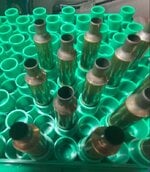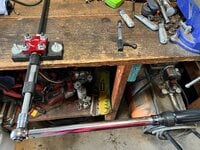TackDriver284
Handloader
- Feb 13, 2016
- 2,933
- 3,134
I have been real busy, but was able to fire off 230 rounds of loaded virgin Alpha brass for my 6 Dasher to be fireformed for my upcoming 600 yard matches but there is an issue that I have been wrangling with. It will be quite a lengthy story, but I'll do my best. The Dasher is a .275 no turn.
I sized all virgin brass with the new Short Action Customs modular sizing die which has the .265" bushing, the bushing can bump the shoulders and size the neck at the same time, and its on a .242" mandrel stem as well, all 3 in one step. I did not bump the shoulders at all, just sized the neck to fireform using 105 Hybrids at the recent matches. After fireforming 230 pieces out of 300 pieces of virgin Alpha brass, inspection of the fired brass shows excellent conditions and smoothness, no carbon on the necks or shoulders at all, accuracy was around .25 MOA @ 100 yards,,,respectable using virgin brass.
I deprimed all 230 pieces, cleaned the body and inside the necks, annealed all the 230 pieces using the " turn off the light and see the glow" method and cleaned the brass again. There is no need for trimming, the length has not grown more than .002", I uniformed the primer pockets with a PMA uniformer. I sized 18 pieces of 1X fired brass bumped .002" on the dot, primed with CCI 450 SR primers, loaded in 3 round groups in .2 increments up to 32 grains. Seated 105 Berger Hybrids .010" off the lands. I was excited to test it, before testing I cleaned the barrel because I had 230 rounds down the tube, no copper traces just some carbon that was removed.
At the range, I shot the first round and noticed heavy carbon on the shoulders all around, strange, and proceeded to fire the rest. All the fired cases have heavy carbon on the shoulders but stopped short of the shoulder / body junction. It seems that the case mouths are not sealing the gases. I was really disappointed so I headed home. I did some measuring on the fired and sized cases, the fired cases are 1.193" headspace, and the sized 1X cases are .1.191", the virgin brass headspace is .288" It seems spot on. Measured the shoulders on the virgin brass, fired and sized brass. Virgin brass shoulder diameter is .457, fired brass is .460 and sized brass is .458
When I bumped the shoulders, I tested it two ways, one is by feel and the other by measuring, fired is 1.193", bumped to 1.192" and bolt close was a little snug, then bumped to 1.191" which closed without resistance. I measured the fired necks and it measures .274" and when sizing it measured .265" and .242 mandrel opened it up to .267 ", and after seating the bullet, it measured at .268", so I'm having .007" clearance or .0035 per side, some might think its excessive, but it seems fine to me because the virgin brass never showed any carbon at all. So I ran a few tests again, I had 70 pieces of virgin brass that was sized along with 230 pieces that was fired, and I used 3 of those virgin pieces and loaded them exactly the same loads I used, also sized 6 pieces more of 2X fired brass, but no annealing this time. Loaded those with 3 pieces .005" off and 3 other pieces at .010" jam. Plus I got 6 more pieces of the 1X fired brass and annealed and loaded the same loads with same jam and .010" off. Tested them and all the fired brass still showed heavy carbon on the shoulders and shots on paper is erratic and did not should small groups at all. Except that the virgin brass loaded at 31.8 grains shot .25 MOA and did NOT show any carbon at all. Went back home to do a final test, I bumped the shoulders to .288" to mimic the virgin brass and loaded 3 and went back to the range, and fired them, it still has heavy carbon on the shoulders. This shit is pissing me off. I bet it could be a defective die from Short Action Customs. I have always used Redding full bushing dies for my other rifles and they work extremely well for me. At this point, I just don't know what else i can do to stop that pesky carbon on my fired brass shoulders. Should I get a new Redding full size bushing die for the Dasher?
Would anyone have a clue? Hopefully someone could help me figure this out.
I sized all virgin brass with the new Short Action Customs modular sizing die which has the .265" bushing, the bushing can bump the shoulders and size the neck at the same time, and its on a .242" mandrel stem as well, all 3 in one step. I did not bump the shoulders at all, just sized the neck to fireform using 105 Hybrids at the recent matches. After fireforming 230 pieces out of 300 pieces of virgin Alpha brass, inspection of the fired brass shows excellent conditions and smoothness, no carbon on the necks or shoulders at all, accuracy was around .25 MOA @ 100 yards,,,respectable using virgin brass.
I deprimed all 230 pieces, cleaned the body and inside the necks, annealed all the 230 pieces using the " turn off the light and see the glow" method and cleaned the brass again. There is no need for trimming, the length has not grown more than .002", I uniformed the primer pockets with a PMA uniformer. I sized 18 pieces of 1X fired brass bumped .002" on the dot, primed with CCI 450 SR primers, loaded in 3 round groups in .2 increments up to 32 grains. Seated 105 Berger Hybrids .010" off the lands. I was excited to test it, before testing I cleaned the barrel because I had 230 rounds down the tube, no copper traces just some carbon that was removed.
At the range, I shot the first round and noticed heavy carbon on the shoulders all around, strange, and proceeded to fire the rest. All the fired cases have heavy carbon on the shoulders but stopped short of the shoulder / body junction. It seems that the case mouths are not sealing the gases. I was really disappointed so I headed home. I did some measuring on the fired and sized cases, the fired cases are 1.193" headspace, and the sized 1X cases are .1.191", the virgin brass headspace is .288" It seems spot on. Measured the shoulders on the virgin brass, fired and sized brass. Virgin brass shoulder diameter is .457, fired brass is .460 and sized brass is .458
When I bumped the shoulders, I tested it two ways, one is by feel and the other by measuring, fired is 1.193", bumped to 1.192" and bolt close was a little snug, then bumped to 1.191" which closed without resistance. I measured the fired necks and it measures .274" and when sizing it measured .265" and .242 mandrel opened it up to .267 ", and after seating the bullet, it measured at .268", so I'm having .007" clearance or .0035 per side, some might think its excessive, but it seems fine to me because the virgin brass never showed any carbon at all. So I ran a few tests again, I had 70 pieces of virgin brass that was sized along with 230 pieces that was fired, and I used 3 of those virgin pieces and loaded them exactly the same loads I used, also sized 6 pieces more of 2X fired brass, but no annealing this time. Loaded those with 3 pieces .005" off and 3 other pieces at .010" jam. Plus I got 6 more pieces of the 1X fired brass and annealed and loaded the same loads with same jam and .010" off. Tested them and all the fired brass still showed heavy carbon on the shoulders and shots on paper is erratic and did not should small groups at all. Except that the virgin brass loaded at 31.8 grains shot .25 MOA and did NOT show any carbon at all. Went back home to do a final test, I bumped the shoulders to .288" to mimic the virgin brass and loaded 3 and went back to the range, and fired them, it still has heavy carbon on the shoulders. This shit is pissing me off. I bet it could be a defective die from Short Action Customs. I have always used Redding full bushing dies for my other rifles and they work extremely well for me. At this point, I just don't know what else i can do to stop that pesky carbon on my fired brass shoulders. Should I get a new Redding full size bushing die for the Dasher?
Would anyone have a clue? Hopefully someone could help me figure this out.







